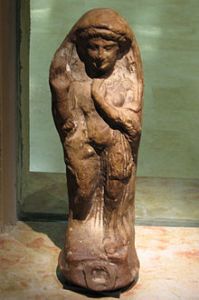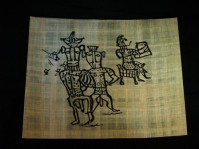 “What remains of God’s purported other half are clues in ancient texts, amulets and figurines unearthed primarily in an ancient Canaanite coastal city, now in modern-day Syria. Inscriptions on pottery found in the Sinai desert also show Yahweh and Asherah were worshipped as a pair, and a passage in the Book of Kings mentions the goddess as being housed in the temple of Yahweh.” – Christy Choi
“What remains of God’s purported other half are clues in ancient texts, amulets and figurines unearthed primarily in an ancient Canaanite coastal city, now in modern-day Syria. Inscriptions on pottery found in the Sinai desert also show Yahweh and Asherah were worshipped as a pair, and a passage in the Book of Kings mentions the goddess as being housed in the temple of Yahweh.” – Christy Choi
 Some scholars say early versions of the Bible featured Asherah, a powerful fertility goddess who may have been God’s wife.
Some scholars say early versions of the Bible featured Asherah, a powerful fertility goddess who may have been God’s wife.
Research by Francesca Stavrakopoulou, a senior lecturer in the department of Theology and Religion at the University of Exeter, unearthed clues to her identity, but good luck finding mention of her in the Bible. If Stavrakopoulou is right, heavy-handed male editors of the text all but removed her from the sacred book.
What remains of God’s purported other half are clues in ancient texts, amulets and figurines unearthed primarily in an ancientCanaanite coastal city, now in modern-day Syria. Inscriptions on pottery found in the Sinai desert also show Yahweh(Jehovah) and Asherah were worshipped as a pair, and a passage in the Book of Kings mentions the goddess as being housed in the temple of Yahweh.
J. Edward Wright, president of The Arizona Center for Judaic Studies and The Albright Institute for Archaeological Research, backs Stavrakopoulou’s findings, saying several Hebrew inscriptions mention “Yahweh and his Asherah.” He adds Asherah was not entirely edited out of the Bible by its male editors.
“Traces of her remain, and based on those traces … we can reconstruct her role in the religions of the Southern Levant,” he told Discovery News.
 Asherah, he says, was an important deity in the Ancient Near East, known for her might and nurturing qualities. She was also known by several other names, including Astarteand Istar. But in English translations Ashereh was translated as “sacred tree.”
Asherah, he says, was an important deity in the Ancient Near East, known for her might and nurturing qualities. She was also known by several other names, including Astarteand Istar. But in English translations Ashereh was translated as “sacred tree.”
“This seems to be in part driven by a modern desire, clearly inspired by the Biblical narratives, to hide Asherah behind a veil once again,” Wright says.
Aaron Brody, director of the Bade Museum and an associate professor of Bible and archaeology at the Pacific School of Religion, says the ancient Israelites were polytheists, with only a “small majority” worshipping God alone. He says it was the exiling of an elite community within Judea and the destruction of the Temple in Jerusalem in 586 B.C that lead to a more “universal vision of strict monotheism.” – Time, 22 March 2011
» Christy Choi writes for the South China Morning Post and lives in Hong Kong.

No comments:
Post a Comment